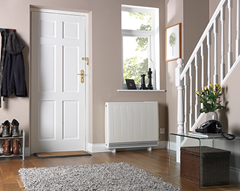Glen Dimplex’s Conor Mullaney
 Electric heating may no longer be in vogue with policy-makers, but 1GW of storage heating and water heating offers the opportunity to facilitate intermittent renewable electricity generation onto the grid. Owen McQuade talks to Conor Mullaney, Glen Dimplex Renewables Development Manager, about this ‘smart’ electricity solution.
Electric heating may no longer be in vogue with policy-makers, but 1GW of storage heating and water heating offers the opportunity to facilitate intermittent renewable electricity generation onto the grid. Owen McQuade talks to Conor Mullaney, Glen Dimplex Renewables Development Manager, about this ‘smart’ electricity solution.
The big issue arising from the increase in the amount of renewable energy sources coming onto the electricity grid is intermittency, particularly for wind generation. To facilitate more wind penetration onto the grid, the storage of electricity, in whatever form, has a premium. Indeed, this is one of the advantages highlighted for the introduction of electric vehicles, which effectively act like batteries on the network. Electric storage heating offers similar advantages and with an estimated 1GW of off-peak electrical storage heating and electrical water heating on the island of Ireland, this is available now.
“There are 240,000 storage heaters in the Republic and seven million in the UK, and that’s a conservative estimate, this together with electric water heating offers a massive storage potential. The concept of a storage heater or a low leakage hot water tank in a house with gas heating enables the use of electricity when the wind blows and allows a shift from fossil fuels to renewables,” observes Mullaney.
However, he goes on to highlight a significant barrier to further developing this potential storage of energy across the network: “The building regulations penalise electric heating at present.”
Although seen by many as old technology, electric heating has improved from the typical storage heater found in the past. Glen Dimplex plans to release its Quantum Energy System to the market this autumn. Developed in conjunction with SSE, it consists of three elements: an ultra-efficient electric heater, a hot water cylinder and the Quantum Hub: an intelligent and automatic system manager, which facilitates the two-way communication between the appliances and the energy supply utility.
The system should increase user comfort while enabling renewable penetration and decarbonisation of the network. To utilise the demand side management advantages “we need to network our products, within the home and out to a developing smart grid, they are no longer stand-alone water or space heating units, operating in isolation.”
Mullaney sees the increasingly connected home as the way forward for utilising this resource: “The technologies to connect the storage heaters to a central point in the cloud are all there. The smart meter roll-out in the UK will start in volume in 2015 and homes will be able to receive a ‘charge’ signal. We are putting a lot of effort into connecting to that smart infrastructure and having the necessary communication hooks on our space and water heating products.”
He adds: “We have this massive storage capacity and we will take your electricity and will use it when you want us to use it and at the same time the householders will get comfort, with improved energy efficiency, which is what they are after.”
Another advantage he highlights is the fact that electricity is a regulated fuel, which is important in addressing fuel poverty as the fuel-poor are protected from oil and LPG price fluctuations.
Glen Dimplex is working with SSE on a pilot scheme in the Shetland Islands using the Quantum Energy System. The heaters are connected to a network management system and the idea is to maximise the use of electricity generated from renewable sources. The isolated network of the Shetlands is seen as a test bed for wider application to the UK grid.
Storage heaters were originally installed to “fill the trough in demand at night” and now offer a similar solution towards coping with the intermittent nature of wind energy. Mullaney sees electrical heating, although now out of favour with policy-makers, becoming a key element of any new smart network. It has also the added advantage of being installed in many homes already.





